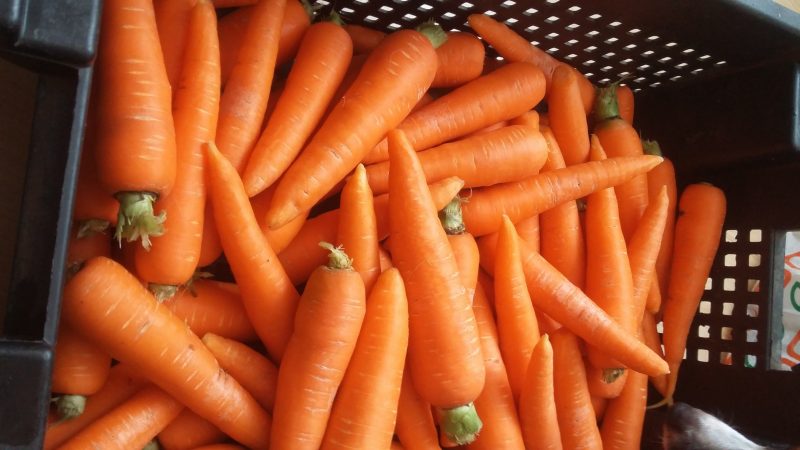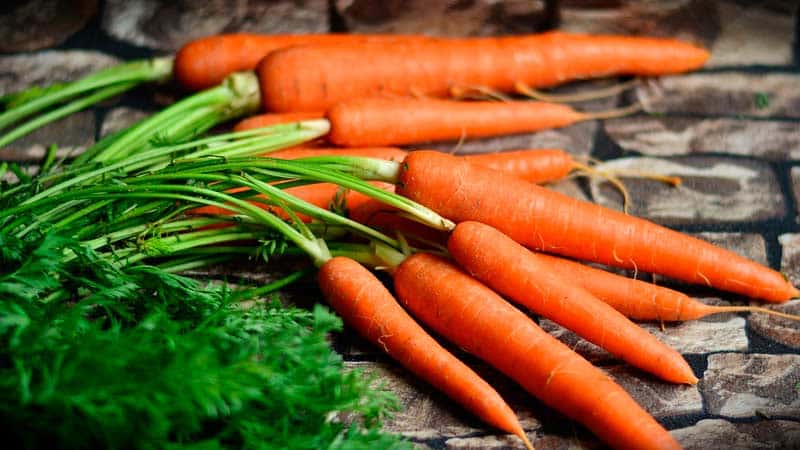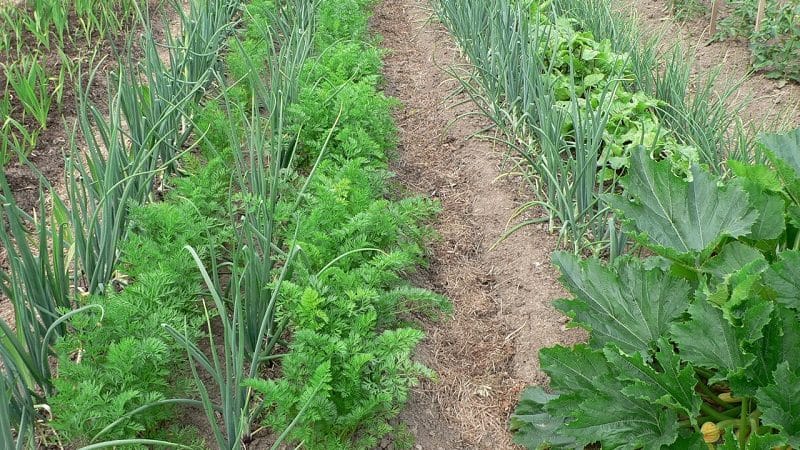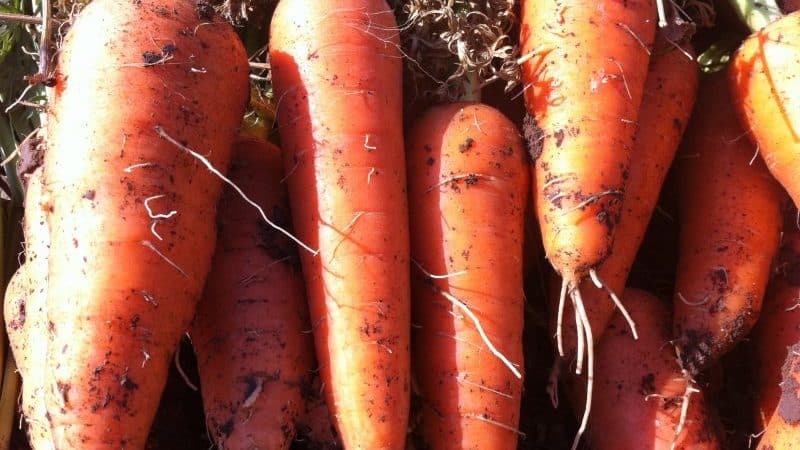What to do if carrots are not sweet and juicy and why this happens
Gardeners often wonder why carrots grow unsweetened and not juicy. Choosing the right variety is only half the battle. There are several factors that are important to consider when cultivating this vegetable. In this article we will tell you how to grow large and sweet carrots on your own plot.
What affects the sweetness of carrots

The sweetness of a vegetable is influenced by the characteristics of the variety, soil, or errors in care. Here are the most common reasons:
- Lack of potassium and phosphorus in the soil. These microelements improve the process of accumulation of sugars in carrots and other root vegetables.
- Excess nitrates in the soil. They not only affect the taste of the vegetable, but when consumed they accumulate and can harm human health.
- Late harvest. If you keep ripe carrots in the ground, they acquire a salty taste. It can be hidden in dishes, but the vegetable becomes unsuitable for eating raw.
- Insufficient watering. The taste of the root crop changes especially noticeably during dry seasons. Carrots need frequent watering. As it ripens, the amount of moisture can be reduced.
- Varieties bred to last storage, may have a slightly bitter and grassy taste. Moreover, these qualities do not appear immediately, but 2-3 weeks after digging.
Factors affecting the quality of root crops

When growing carrots, attention is paid to the composition of the soil, lighting, watering and other conditions that affect the taste and quality of the crop.
Predecessors
Before planting carrots, check what was previously grown in this area.The crops that occupied the bed can affect the taste of the root vegetable - positively or negatively.
Ideal “predecessors” that will benefit root vegetables:
- cucumbers;
- tomatoes;
- potato;
- cabbage;
- garlic;
- onion.
You cannot plant carrots after growing:
- parsley;
- dill;
- parsnip;
- celery.

Place of cultivation
The key to tasty carrots is a well-lit place. In darkened beds, yields drop and the taste of the vegetable deteriorates sharply. Therefore, it is important to choose a flat area for it, on which the sun's rays fall all day.
Important! It is not recommended to grow carrots in the same place for several years in a row. It is advisable to change it every season.
Soil preparation
Even the best varieties They will not be able to fully express their taste in unsuitable soil. Heavy, clayey or acidic soil is detrimental to carrots. In such soil, root vegetables turn out small, deformed and with an unpleasant, grassy taste. A large number of small roots on root crops is also a sign of improper soil composition.
To get a sweet and juicy harvest, the vegetable is planted in light sandy or loamy soil. The acidity level should be low or neutral. Carrots prefer loose and fertile soil. It is desirable that the arable layer is at least 28-32 cm.
Important! To improve the quality of the harvest and the taste of carrots, potassium and phosphorus are added to the soil in the fall (before spring planting). They are necessary for the formation of sweet, even and beautiful root crops for next year.
Boarding time
It can be planted in early spring, early summer or autumn. Carrots are a cold-resistant crop. Its seeds will germinate even at temperatures of –3…–4°C. But for landings It is advisable to wait until the soil warms up to at least +3...+5°C. Before winter, carrots are planted in late October - early November.
Important! Winter varieties are not recommended to be planted before the end of October. Carrots can germinate and die when frozen. The “third wave” of landings is relevant for central Russia. In areas with harsher climates, seeds may die even under a thick layer of covering material.
Early ripening and winter varieties are not suitable for winter storage, but they will provide fresh carrots on your table. Vegetables planted in June are easily stored until spring.
For planting in early spring, the beds are prepared in the fall, the seeds are soaked in water to speed up germination. The seeds of “summer” carrots are not soaked; they sprout quickly anyway. It is most convenient to sow on a tape, so as not to thin out the beds later.
Fertilizers
For normal development, it is enough to feed carrots 2-3 times per season. The first fertilizer is applied 2-3 weeks after emergence.
Composition used:
- potassium nitrate - 20 g;
- urea - 15 g;
- concentrated phosphorus fertilizer - 15 g;
- water - 10 l.
The soil must be fertilized a second time after another 2-3 weeks. Suitable solution:
- potassium chloride - 20 g;
- complex mineral fertilizer - 20 g;
- water - 10 l.
If the crop develops poorly and has pale leaves, there may be a lack of nitrogen in the soil. To compensate, carrots are fertilized with bird droppings or mullein. For 1 bucket of water - 1 liter of product. To enhance the effect, add a little urea. To ensure better storage of the crop, the vegetable is fed with potassium chloride a month before harvesting. And for the sweet carrot taste, wood ash is used: at the rate of 100 g of ash per 1 m².
Important! Fresh manure is not suitable for fertilizer. He will attract pests and will make the situation worse.
Watering mode
Lack of moisture is one of the main reasons for bitterness and wilting of root vegetables. Carrots are watered once every 3-5 days with water at room temperature. It is not advisable to water directly from a well, borehole or water supply. A weak root system does not absorb low temperature water. It can also cause root rot. It is better to let the water settle and warm up in a special container.
To avoid flooding the plant, especially at the seedling stage, use a watering can with a divider and low water pressure for watering. You will have to give up watering with a hose. The bed with the grown vegetable is watered so that the soil is moist to a depth of 30 cm.
Important! Water carrots in the evening. This will protect the plant from moisture evaporation.
Thinning
In order to obtain large and even root crops, it is important to prevent the crops from becoming dense. The first thinning will be needed as soon as real leaves appear on the plants. At this moment, the distance between the “neighbors” is left about 2-3 cm. If the seeds were planted sparsely, this stage can be skipped.
The signal for repeated thinning is the appearance of two pairs of leaves. Now the distance between the carrots is doubled.
Weeds
Weeding carrots is a mandatory process: weeds draw strength and sweetness from the carrots. Weeds are removed as soon as they appear; their roots are still weak and can be easily removed from the soil.
If carrots are planted in even rows, the row spacing is periodically loosened. To do this, use a Fokin flat cutter or any other convenient tool. An alternative option is to cover the row spaces with strips of film.
Diseases and pests
One of the advantages of carrots is that they are less susceptible to diseases and pests. Its main enemy is the carrot fly. The presence of the parasite can be seen by the curled leaves. However, it will attack the crop only if you make mistakes in care. The carrot fly prefers beds that are overgrown with weeds, thickened or too wet. If the insect appears, the drugs “Inta-vir” and “Actellik” will help get rid of it.
With general immunity to diseases, carrots can be affected by Alternaria (“black rot”) or Phoma. To reduce the risk of diseases, the beds are treated with a 1% solution of Bordeaux mixture.
The sweetest and juiciest varieties of carrots

The best results and harvest will be ensured by proper care of carrots and the right choice of variety. Here are a few varieties preferred by experienced gardeners.
The sweetest varieties and hybrids:
- Maestro F1;
- Children's sweet;
- Emperor;
- Bolero F1;
- Caramel;
- Amsterdam.
The largest varieties and hybrids:
- Canada F1;
- Nandrin F1;
- Nantes 4;
- Shantanay;
- Yellow carrots;
- White carrots.
Conclusion
The sweetness and juiciness of carrots is affected by many factors, from insufficient watering to a lack of microelements in the soil. To get a decent harvest, choose the right variety and place in the garden, prepare the soil, apply fertilizers on time and remove weeds. Follow the watering schedule and prevent pests from appearing.